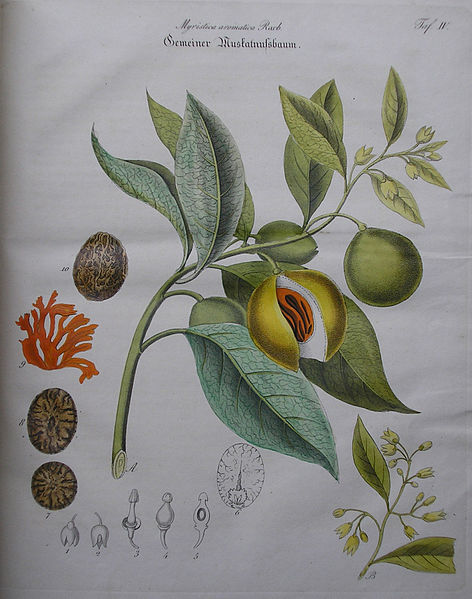Reproduction
Myristica fragrans is a dioecious angiosperm. This means that there are male and female trees that bear seeds and pollen, and there are no asexual species of Myristica fragrans. In order for the species to reproduce, they must be pollinated. It’s not very well known how this is done, but research suggests that the beetle Formicomus braminus is the most likely candidate for pollination. The beetle is a strong flier and appears around the staminate flowers nocturnally. In addition, the beetle carries a high number of pollen spores. If the beetle is the pollinator for nutmeg, it would have a mutualistic relationship with the nutmeg. Other feasible hypothesis suggests that the trees pollinate via the wind. It has been observed that Myristica fragrans produce 800,001 pollen-bearing male plants for every 1 ovule-bearing female plant. This makes the possibility of wind fertilization a very likely hypothesis. Other researchers suggest that smaller insects or moths are also likely symbionts.
The staminate, or flowers with female organs, are born indeterminate inflorescences (clusters) and function for only a single night, whereas pistillate flowers (flowers with male organs) are borne solitarily and possess pollen for 2-3 days. The most active season of reproduction for Myristica fragrans is November to January because it is shortly after the fall monsoon season.
Humans are the primary consumers of Myristica fragrans as a spice in a wide variety of foods but also as a preservative, a source of essential oils, medicines, hallucinogens, and can be used as a disinfecting agent. Recent studies also suggest that nutmeg can be used as an antifungal agent. It is thought that mace might also be hallucinogenic, but more research is needed to prove this to be true. Nutmeg has also been documented to be used as an abortifacient in England and India. Saffron, another organism, is also used in Indian culture as a spice and in medicine.
The oil of the nutmeg is extremely complex, but Myristicin, which makes up about 4 percent of the oil has the chemical formula: C11H12O3 . Myristicin is responsible for many of the pharmaceutical effects of nutmeg and mace. Myristicin was used for a wide range of disorders, but mostly for upset areas in the mouth and stomach. In Arab cultures Myristicin was even used as a aphrodisiac. Nutmeg is valued by natives around the world, but most dominantly in Arab and Indian cultures, and is considered one of their most valuable medicines.
I'm sure all of you have heard the rumor: if you eat large amounts of nutmeg, you will hallucinate. This is true; nutmeg can be used as a legal hallucinogenic, but before you go off and "trip out of your mind," you might want to read how this organic narcotic will affect you. People who choose to take nutmeg as a narcotic should be able to tolerate mild to extreme discomfort for a prolonged period of time (twenty-four hours or more, sometimes even multiple days, depending on dosage and tolerance). To get "high" off nutmeg the average human must consume 5-20 grams of powder, or 1-3 whole seeds. If you've never eaten nutmeg before, this is a lot and does not taste very well if eaten plain. Symptoms of high consumption of nutmeg include excessive thirst, dizziness, nausea, vomiting, feeling of pressure in chest or stomach, dry mouth, stomach ache, seizures, and even death! Some people also have reported loose bowels and and "nutmeg burps." Usually the effects of nutmeg take around six hours to kick in. When they do, users reported feeling like they were floating and slowed down thought processes. Some noteworthy people that have admitted to using nutmeg as a narcotic include Charlie Parker, and Malcom X. Myristicin shares chemical structures similar to mescaline, amphetamine, and ecstasy. A lot is still unknown about adverse effects related to nutmeg poisoning, so if you decide to be adventurous, it's advised you be very cautious. To learn about hemp, an organism that also can make you high, click here.





